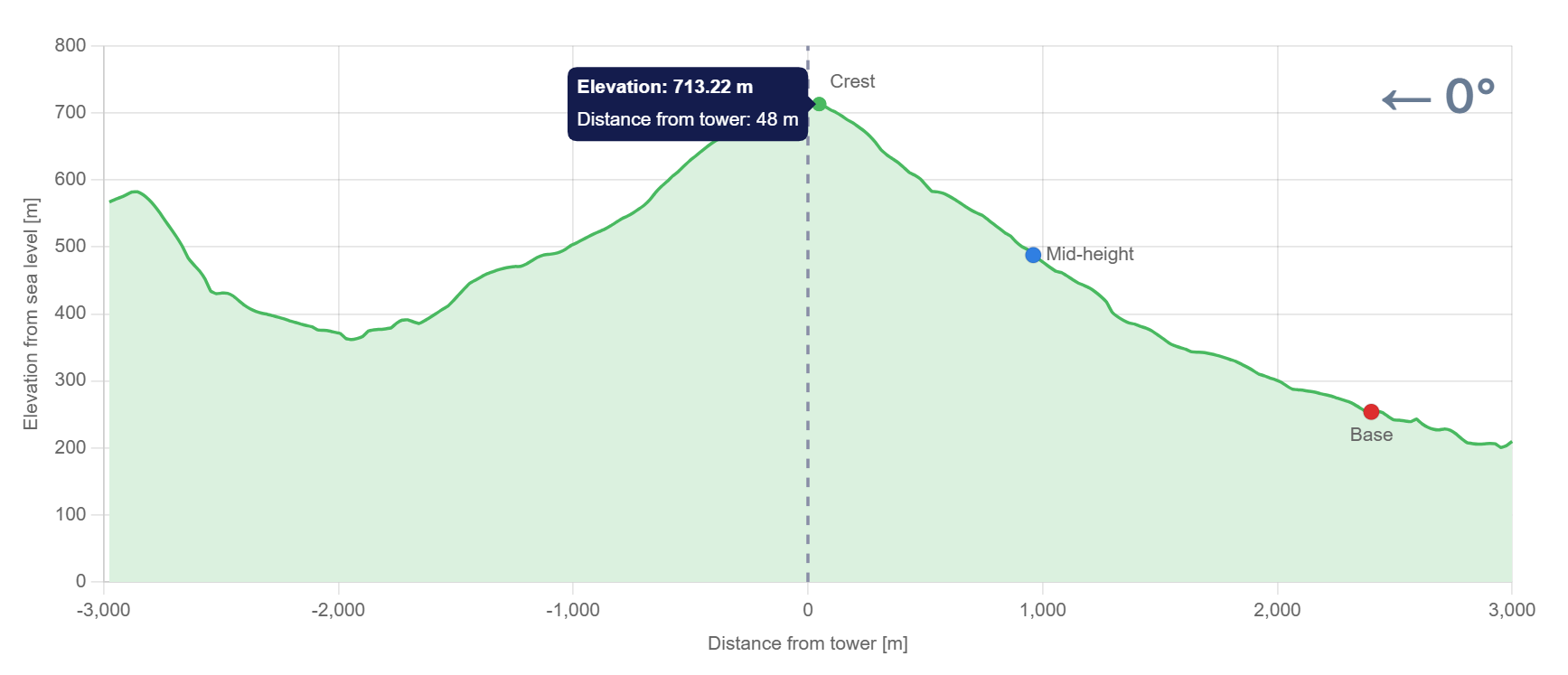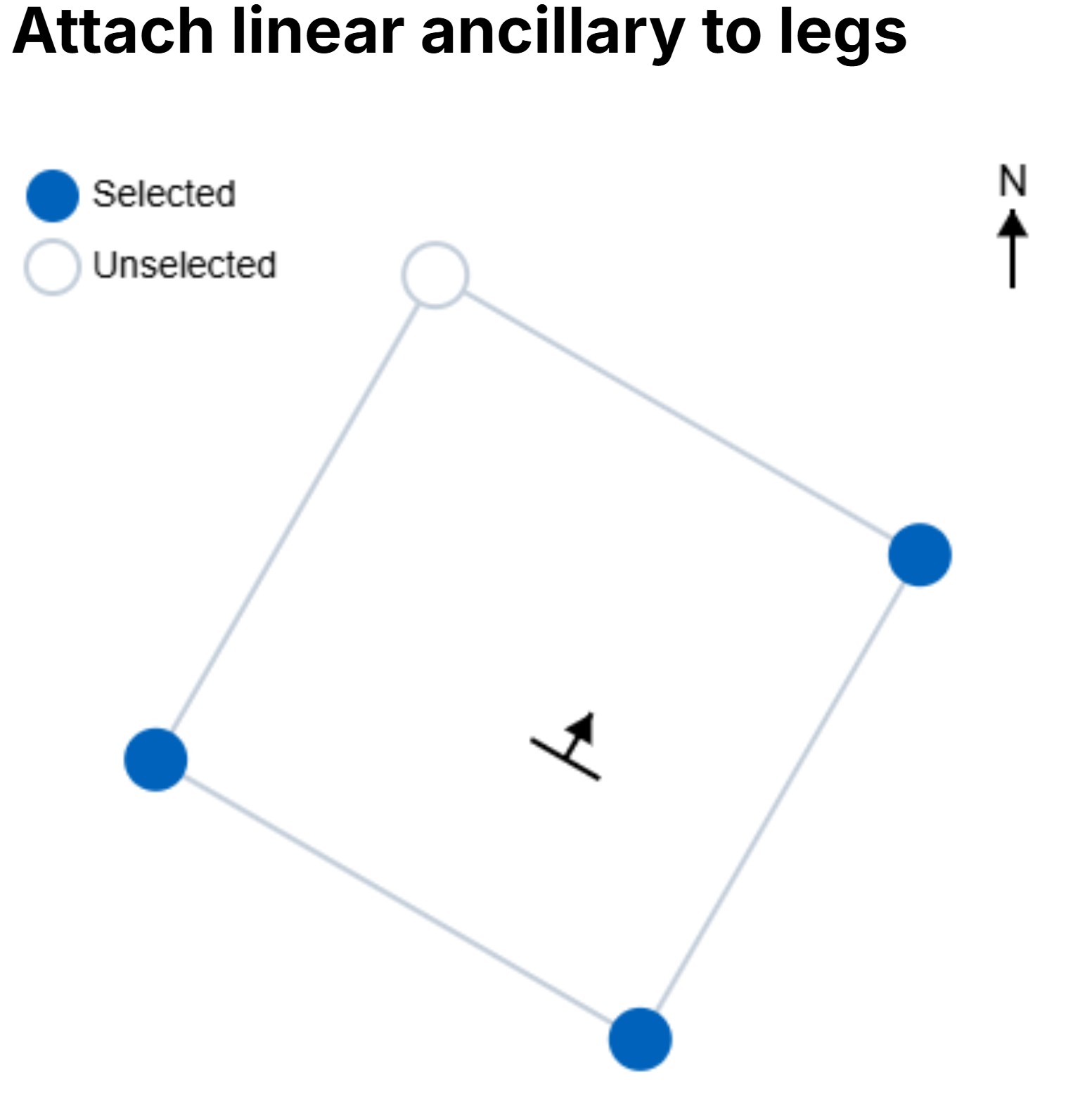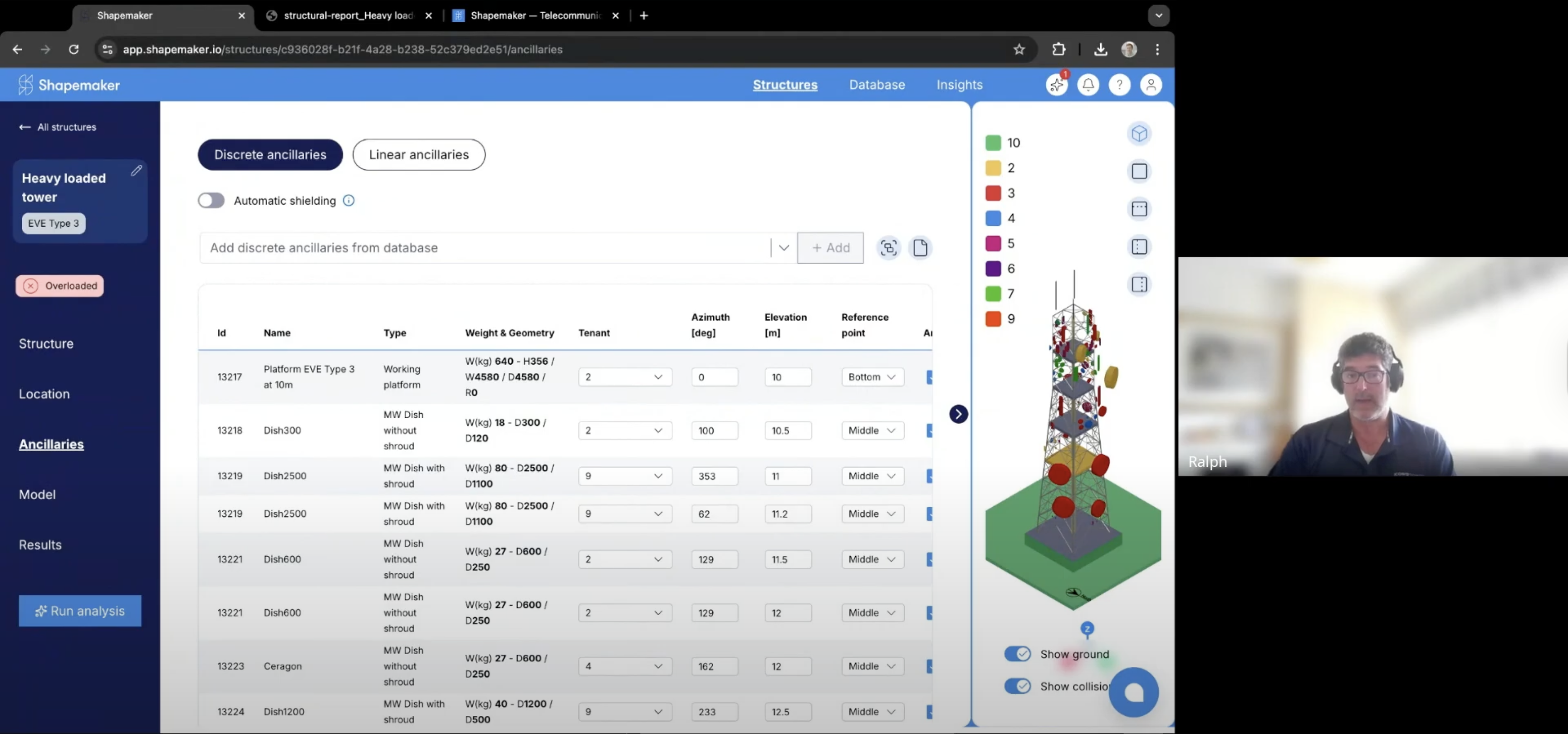To ensure accurate and reliable wind load estimations, site-specific assessments are essential. We have implemented a system that enables the automatic evaluation of relevant site-specific parameters, available under the Location tab for each site.
Among the environmental factors influencing the design wind pressure used in the analysis of telecommunication structures, the following are distinguished:
- Fundamental value of basic wind velocity
- Terrain roughness category
- Terrain orography parameters
In the British and Irish approaches, it is additionally required to specify the distance of the structure from the sea and from the city boundary, if the structure is located within an urban area.
All of the above factors should be considered individually for every site, taking into account their variability depending on the wind direction.
In Shapemaker, each of these parameters for all considered wind directions is determined automatically after selecting the site on the map or by entering the location coordinates (latitude and longitude) and choosing the applicable National Annex for the Eurocode.

The entire process runs in the background, and the user receives the computed parameters, which - if justified - can be manually adjusted.
By default, the analysis is performed for 8 directions (every 45°) for four-legged towers and monopoles, and for 12 directions (every 30°) for three-legged towers. Wind directions can be modified manually by the user.
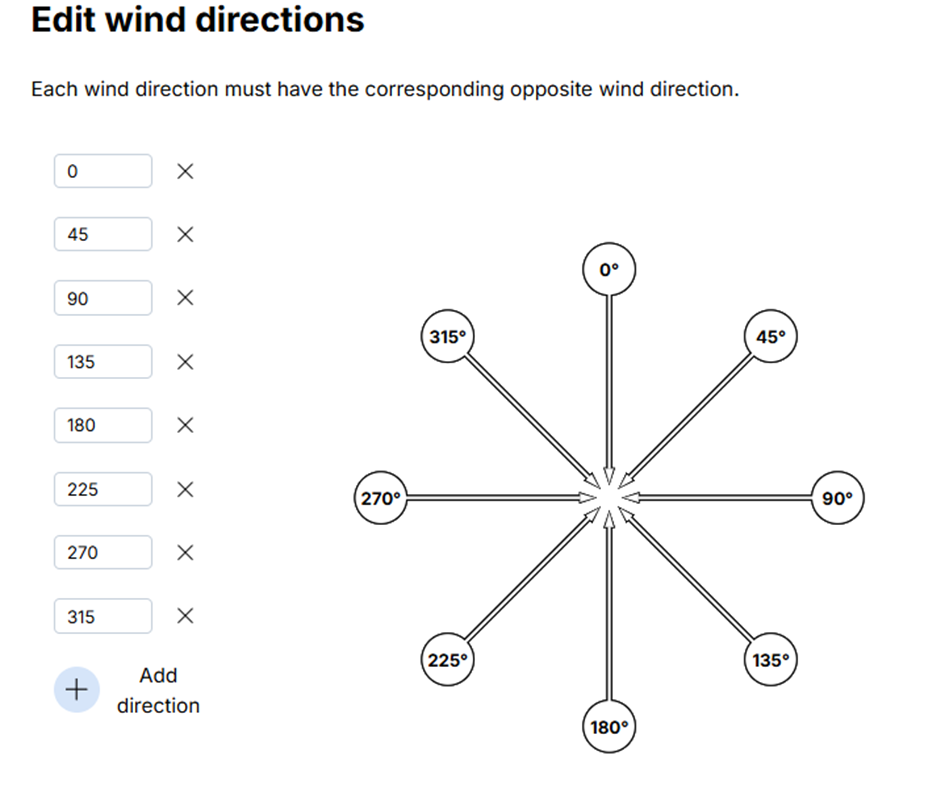
In the following article, I will explain the processes behind the analysis described above.
1. Fundamental value of basic wind velocity assessment
Let us begin with the simplest parameter - the fundamental value of the basic wind speed.
This parameter is constant for all directions, so there is no need to determine it repeatedly for each wind direction.
To determine wind loads according to Eurocode EN 1991-1-4, Chapter 4, the reference value of the wind speed is required.
The standard, in clause 4.2 (1)P, defines it as follows:
The fundamental value of the basic wind velocity, vb,0, is the characteristic 10-minute mean wind velocity, irrespective of wind direction and time of year, at 10 m above ground level in open country terrain with low vegetation such as grass and isolated obstacles with separations of at least 20 obstacle heights.
The vb,0 values are provided in the National Annexes to the standard in the form of maps or tables showing the areas associated with specific values.
Our application includes digital data defining the boundaries of the wind zones specified in the respective standards. Based on the input site coordinates and the selected National Annex of the Eurocode, the algorithm identifies the zone in which the structure is located and assigns the corresponding fundamental value of basic wind velocity.
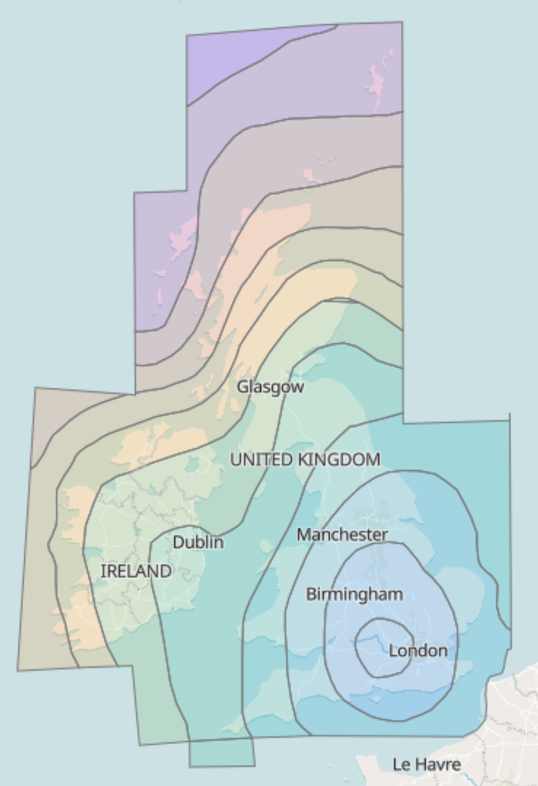
If a revision of the wind speed is required due to altitude above sea level, which is applicable in some countries, the application determines this altitude using high-resolution data from the GPXZ service. The wind speed value is then adjusted in accordance with the methodology specified in the relevant National Annex to EN 1991-1-4.
2. Terrain roughness category assessment
The parameters of terrain roughness, which affect the wind speed and therefore the wind pressure, are defined in the Eurocode standard based on terrain roughness categories.
Five categories from 0 to IV are defined in the Table 4.1 and Annex A of generic EN 1991-1-4 standard. However, many National Annexes modify this list - in Shapemaker you will always find the classification appropriate for the selected standard, and the algorithm will automatically adapt to it.
The generic Eurocode classification is as follows:
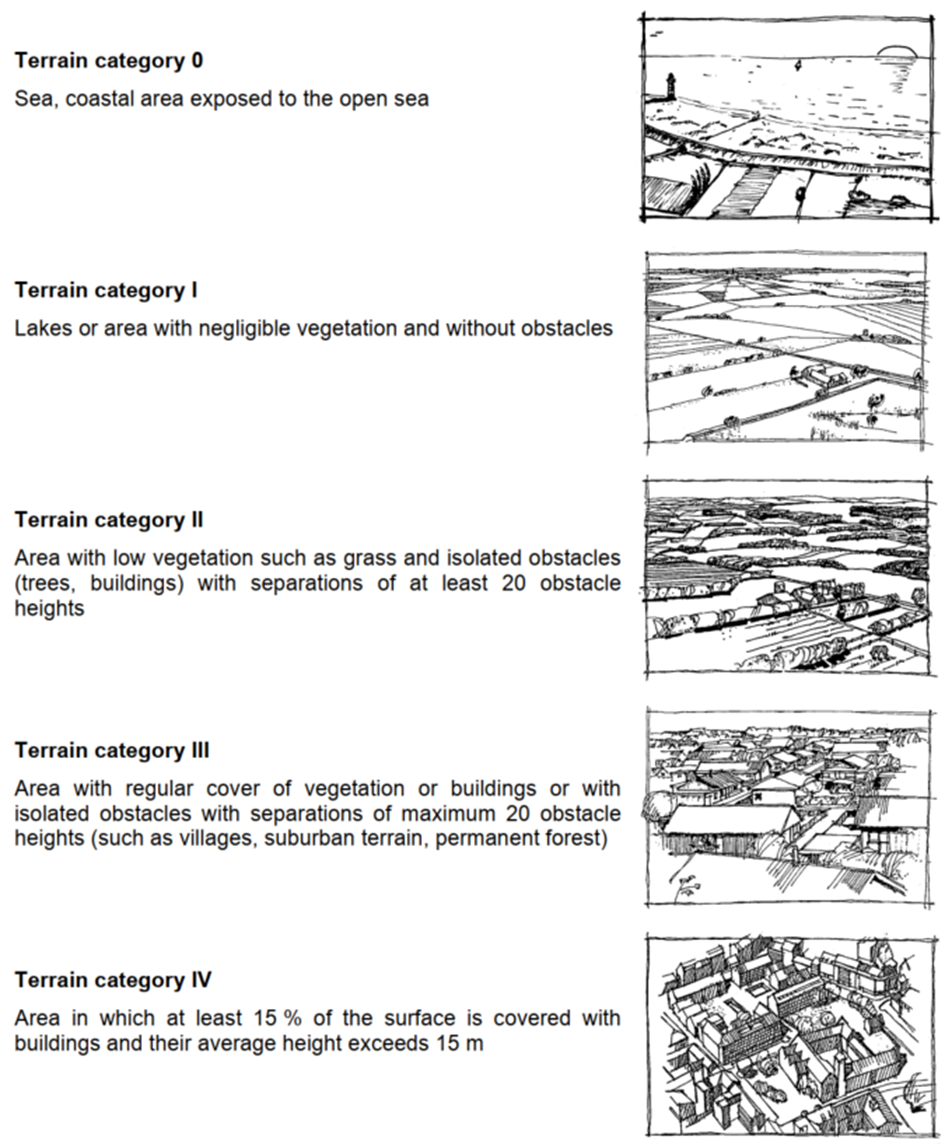
The terrain roughness category is determined individually for each wind direction. We believe that analyzing each direction separately - especially with precise antenna and cable route positioning - provides measurable benefits in the form of lower structural utilization.
The process involves scanning terrain sectors located along the wind path towards the structure. Each sector spans ±45° around the nominal direction, and the scanning is performed iteratively within 30° sectors, with a 5° step between successive iterations.
Typically, sectors with radii of 1 km, 2 km, and 5 km are analyzed; however, in some countries, local guidelines specify different radii and such is used in our assessment.
The data for each sector comes from high-resolution ESA WorldCover 2021 and S2GLC Europe 2017 land cover maps, which classify every 10 m × 10 m grid cell into one of 14 land cover categories:
- Artificial surfaces and constructions
- Cultivated areas
- Vineyards
- Herbaceous vegetation
- Broadleaf tree cover
- Coniferous tree cover
- Moors and heathland
- Sclerophyllous vegetation
- Natural material surfaces
- Permanent snow and glaciers
- Marshes
- Peatbogs
- Water bodies
- Clouds
The example below illustrates the result of scanning one of the 13 (every 5°) thirty-degree sectors analyzed during the determination of the terrain category for a single wind direction.
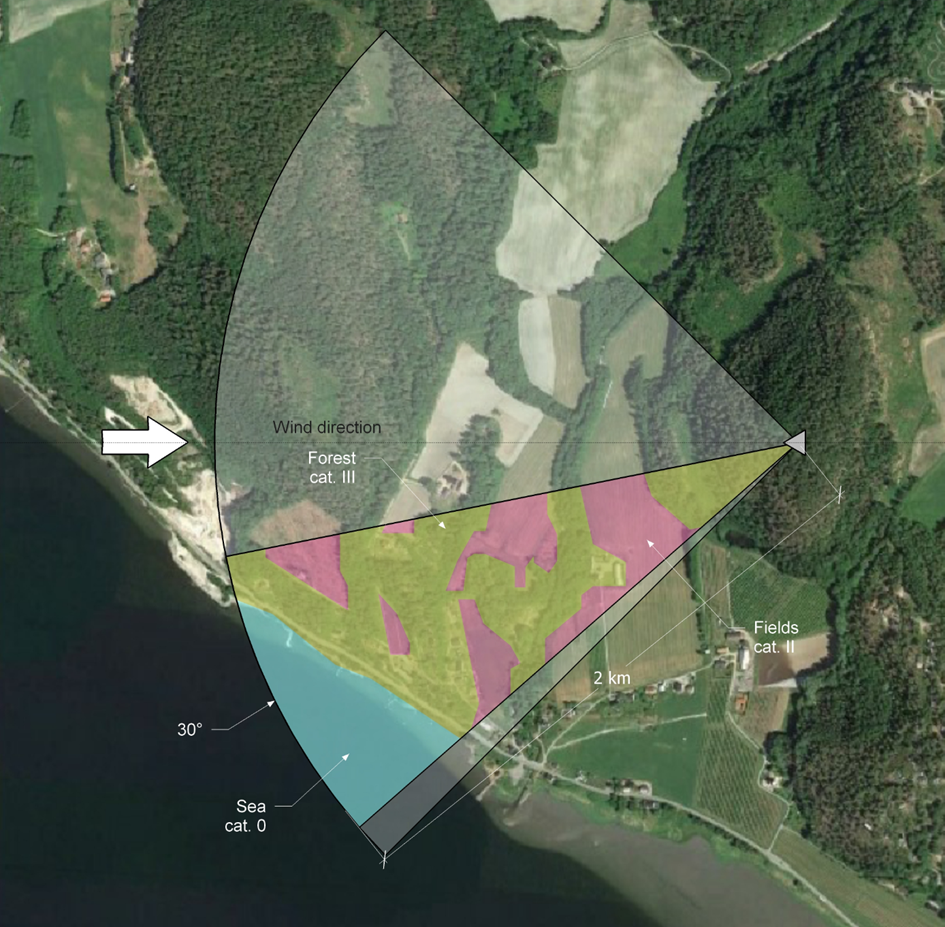
The outcome of this scanning process provides information on whether large water bodies are present in the vicinity of the structure - specifically, whether they cover more than 50% of a 5 km radius sector - meaning there is a high probability of the sea or the ocean around the site. Additionally, the surface areas covered by the remaining 13 categories are identified.
The algorithm then assigns a preliminary terrain roughness category to each land cover type found within the sector, according to the Available options defined in the corresponding National Annex.
Areas classified as Clouds - meaning areas with missing data - are by definition assigned to the lowest roughness category.
Following the generic Eurocode approach, if a terrain roughness category occupies less than 10% of the sector area, it is disregarded.
Next, the algorithm evaluates the percentage of the sector covered by Artificial surfaces and constructions and, together with other cover types, determines the degree of urbanization of the sector.
Our general assumptions (for the generic EN 1991-1-4 standard) for a 1 km radius sector assigns the below categories for cases checked in the below order:
- Presence of a large water reservoir: category 0
- Water coverage > 10%: category I
- Artificial surfaces and constructions > 30%: category IV
- Artificial surfaces and constructions > 15%: category III
- The considered category exceeds the percentage of Artificial surfaces and constructions by more than 10%, the lowest category meeting this criterion is adopted
The above algorithm is adapted for each National Annex that defines terrain roughness categories differently from the generic standard, so criteria shown above should be valid only when using the generic Eurocode.
As a result of this analysis, Shapemaker produces 13 roughness category values for each nominal wind direction, from which the lowest category (with the lowest roughness) is adopted as decisive for that direction.
The results for all wind directions are visible under the Wind rose tab or by clicking the Edit wind profile button, and they are also included in the final analysis report.
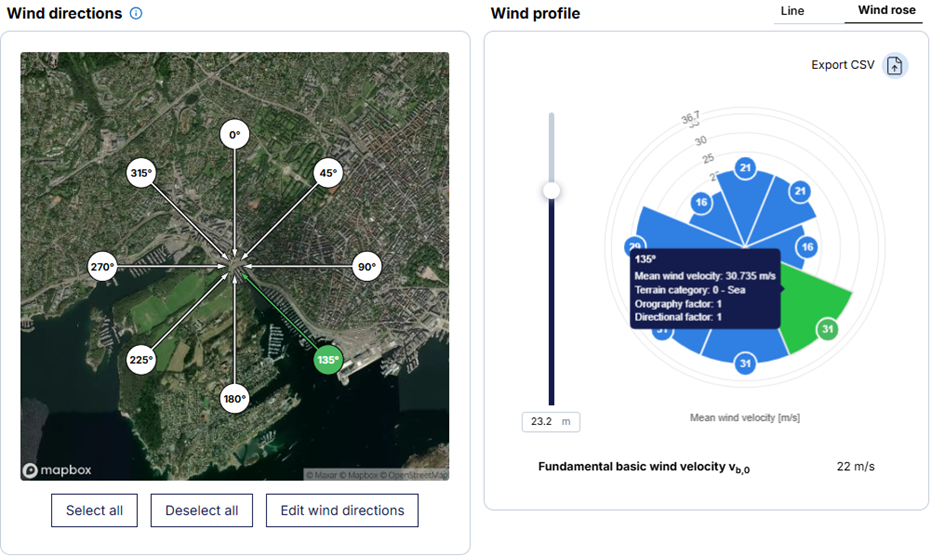
The data used in the process originates from 2021 (or 2017 for older datasets), and all non-obvious assumptions in the algorithm defining the roughness classification have been made conservatively.
Consequently, users are required to review the estimated values and, where appropriate, make manual adjustments via the Edit wind profile option.
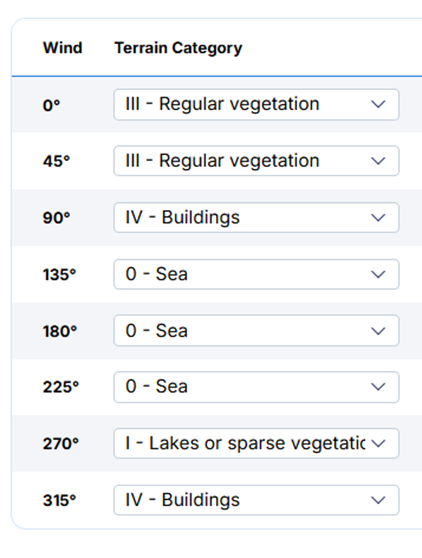
In the approach used in the United Kingdom and Ireland National Annexes to the Eurocode, the estimated roughness category must be assigned to one of two options:
- Town
- Country
Additionally, the distance of the structure from the shoreline and from the town boundary (if the structure is located within an urban area and further than 100 m from its border) must be determined.
The datasets used to determine these distances come from publicly available geospatial data sources, including the UK CEH Environmental Information Data Centre, Tailte Éireann, and Urban Morphological Zones for Europe (see references).
Both parameters can be altered manually.
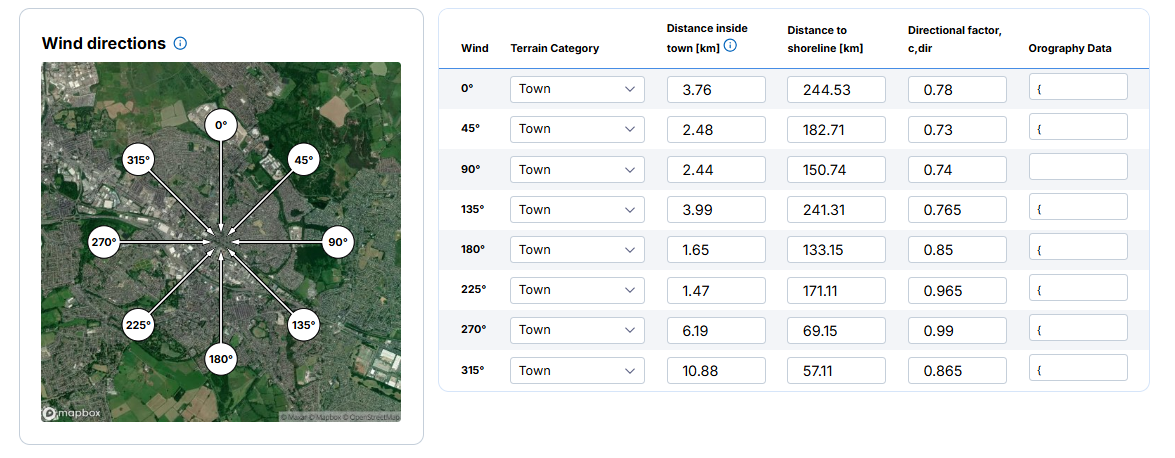
3. Orography Data assessment
Upwind and downwind terrain topography around the site is an important factor in wind load assessment, as the sites located near the crest of slopes, hills, ridges, escarpments, or cliffs are subject to higher wind loads than sites on flat terrain or far from such features, due to the speed-up effect that occurs around these landforms.
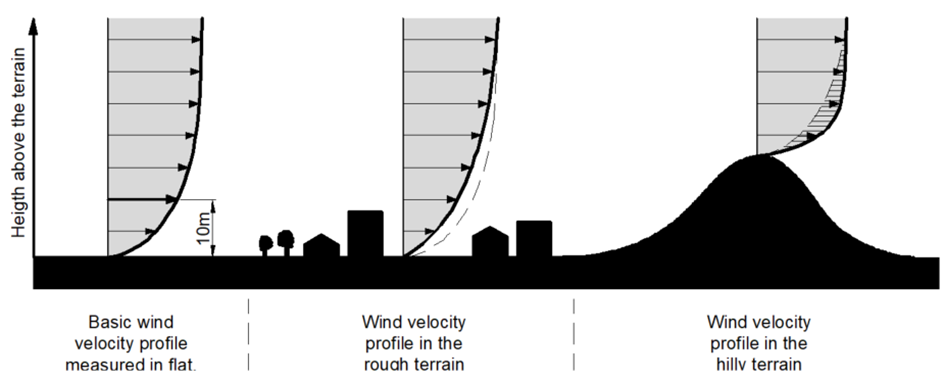
According to Eurocode EN 1991-1-4, Annex A.3 describes the situations in which the influence of terrain topography must be considered.
These include cases where:
- The feature is isolated from the surrounding terrain
- The average slope of the upwind terrain is greater than 3°
- The slope steepness exceeds 5%.
Features with a downwind slope of less than 5% are considered escarpments (or cliffs).
To calculate the effect of terrain topography on a structure defined as the orography factor, several terrain profile parameters must be determined:
- Type of the feature
- Effective feature height (H)
- Length of the upwind slope in the wind direction (Lu)
- Length of the downwind slope in the wind direction (Ld) - not applicable for escarpments
- Horizontal distance from the site to the crest (X).
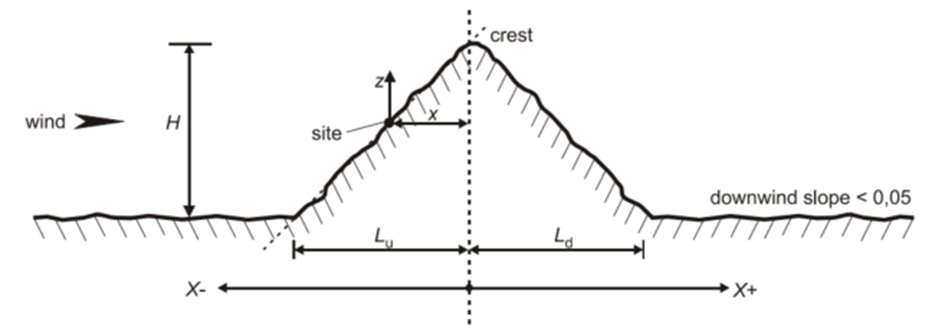
In Shapemaker, the procedure follows the methodology defined in Annex A.3 of the generic version of EN 1991-1-4.
The assessment is carried out individually for each wind direction considered in the analysis, since the direction corresponding to the maximum effective wind area of the tower and ancillaries rarely coincides with the wind direction producing the highest topographic speed-up or the roughness category with the greatest influence. Performing the assessment separately for each wind direction therefore results in lower tower utilization and greater capacity, which in turn positively impacts the tower owner’s income.
The orography data evaluation for a single wind direction proceeds as follows:
- Elevation data are obtained from the GPXZ service for 250 points along the considered wind direction, within a radius of 3218.7 m (2 miles) before and after the structure.
The 2-mile distance is adopted from TIA-222-I, section 2.6.6.1, since the Eurocode does not specify the length of terrain to be analyzed in the preliminary stage.
The GPXZ service consolidates data from multiple sources and provides elevation data with a minimum resolution of 30 m - reaching up to 0.5 m in many Western and Northern European countries. - The terrain profile is then divided into all possible start + end point combinations (called samples), each of which undergoes further analysis.
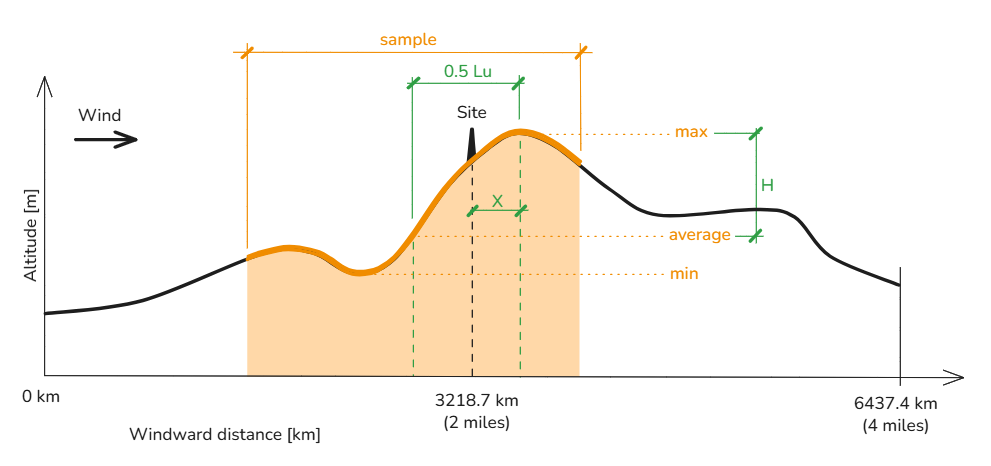
- For each sample, the maximum, minimum, and average altitude values are determined, along with the horizontal distances between the points corresponding to these altitudes and the speed-up factor.
- If the calculated wind speed-up is negligible for all samples, the influence of terrain orography in that direction is omitted and the orography factor is 1 per this direction.
- For the sample where the speed-up factor reaches its maximum, a trapezoid is fitted - defined by the top plateau width and the slope corresponding to the smallest squared deviations, using the Levenberg–Marquardt algorithm.
- The following parameters are then calculated:
- horizontal distance from the structure to the crest: parameter X,
- difference between maximum and mean elevation: parameter H,
- Twice the horizontal distance from the crest to the intersection of the trapezoid arm with the average altitude on the upwind side: parameter Lu,
- Twice the horizontal distance from the crest to the intersection of the trapezoid arm with the average altitude on the downwind side: parameter Ld.
- Finally, the type of terrain feature is identified as per the following criteria:
If the slope on the opposite side of the wind direction is very small, the feature is classified as an Escarpment.
If the estimated plateau width exceeds 30 m (the minimum assumed value), the feature is classified as a Flat topped hill.
In all other cases, the feature is defined as a Hill.
Once the assessment is completed for all wind directions, the user can review the obtained values under the Orography tab.
The assessment results are updated with the orography factor (co) calculated at 10 m above the terrain level.
At this stage, the user is recommended to review the calculated parameters and adjust them if the terrain profile appears different from the one interpreted by the automatic algorithm.
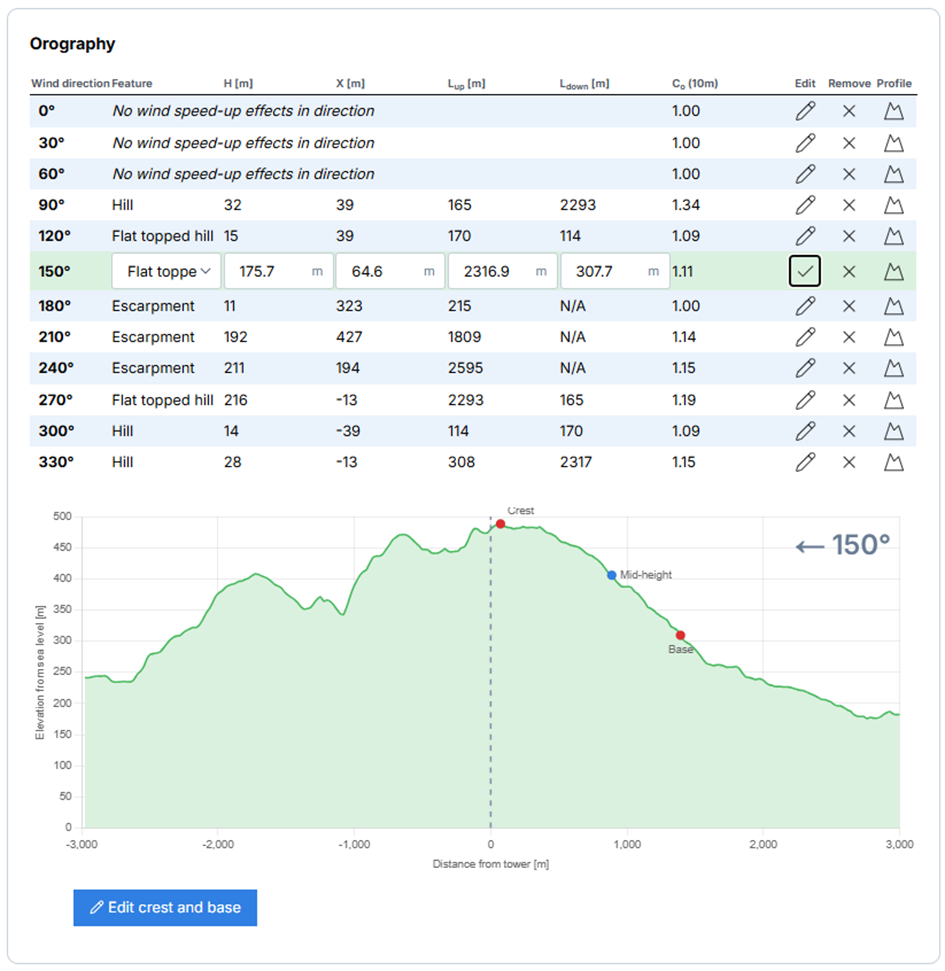
Shapemaker allows for a fully automatic assessment of all site parameters required for wind load determination. However, it must be emphasized that the user is ultimately responsible for verifying the accuracy of the automatically generated data before performing any structural calculations.


